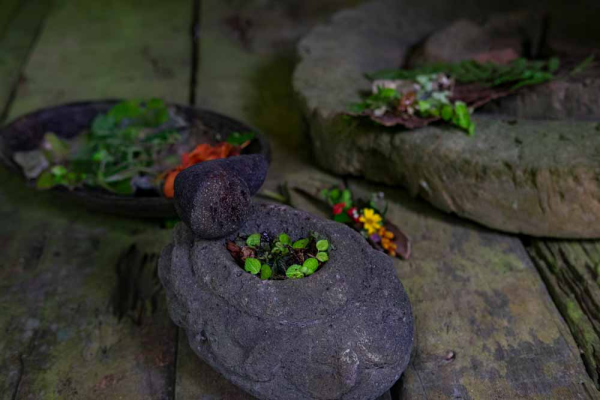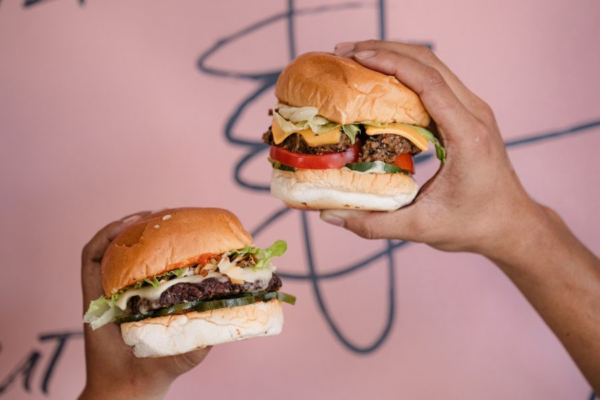Flowers, leaves, rice crackers and incense – here’s all you need to know about Canang Sari, AKA the colourful offerings laid out every day in Bali…
If you’ve ever been to Bali, I bet you’ve seen the little boxes of flowers all around the island. They are placed almost everywhere, in temples, on street corners, and set atop books, cashiers and even cars. So, let’s learn more about these offerings, why you see them everywhere in Bali, and the philosophy behind them…
Canang Sari: All you need to know
The little offerings of colourful flowers and leaves are known as “Canang Sari”, which literally means ‘a beautiful purpose’, and they come in all shapes and sizes. The most common might be the round and square leaf plates with colourful flowers on top, but they also take the form of larger baskets carrying flowers, fruits (like bananas and oranges), along with dried rice crackers on top.
No matter their size or shape, within the elaborate array of florals and fruit lies the “porosan”, a small dried pack of green betel leaf with some white lime and a reddish slice of Gambir fruit. You might not even notice the porosan as it is usually placed under a pile of petals.
The colours (and meaning) of Canang Sari

Porosan is the ‘centre’ or ‘essence’ of the Canang Sari, an offering of chewing betel leaf that is intrinsic to South Asian and Austronesian culture for generations. This indigenous expression of hospitality later met with Hinduism, and in Bali, these three essentials got associated with the three main gods of Hinduism; the greenish black betel leaf is Wishnu, the white lime is Shiwa and the red Gambir fruit is Brahma.
The Porosan is placed in the middle of the leaf basket, weaved out of young palm leaves or sometimes banana leaves. They point in different directions, representing a flower or a compass. The flowers are then placed atop, being considerate of which colours are present. The three gods of Wishnu, Shiwa and Brahma are represented with colours, but also have directions associated with them. Lord Shiwa expands Himself into seven forms, joining Brahma and Whisnu. Together, these nine divinities take up directional posts, hold weapons, have mantras, and have colours associated with them.
This is common practice in “Tantra”, a process by which the gods are attributed with icons, symbols, mantras and patterns to create intricate rituals. The colours are then arranged following the “Mandala” or the circular arrangement of the gods and their respective colours. The colour black represents Wishnu in the North. The red flowers are Brahma in the South. The white flowers are Ishwara in the East. The blue is Shambu in the North-East. The pink is Maheswara in the South-East. The orange is Rudra in the South-West. Followed by the yellow Mahadewa (West) and the green Shankara (North-West). Shiwa resides in the centre, represented by all the colours.
The colours and the gods associated with them are heavily applied all over Bali, considerate of which direction and which god that colour is meant to represent. However, the flower Mandala of the Canang Sari does not strictly follow the directions, and thus you won’t find them arranged in correspondence to the direction and colour they face.
The daily Canang Sari offerings

What remains central to the Canang Sari offering is beauty and practicality. And this is because each household would offer at least fifteen of these a day, and that number can easily go up to the hundreds on special occasions! Each Canang is placed at specific spots around the home. These spots include wells, entrances, fires, granaries, crops, livestock, vaults and the many altars and shrines. They are placed to appreciate these essentials that we rely on.
Along with the Canang, most households would also offer the “Saiban”, a small piece of banana leaf with cooked rice and some other food offerings. This is to share their portion of meals with other creatures in the home, whether seen (such as the livestock, the ants and the dogs) or the unseen (like the spirits, ghosts and demigods). The Balinese, and Hindus in general, see humankind as central to the cosmic balance. Thus, it is their “Dharma” or ‘duty/obligation’ to respect, nurture and share with nature, the spirits, the ancestors and demigods.
The finale: Holy water, incense and mantra

No offering is complete without the holy water, incense and mantra. The holy water is sprinkled on the offering to purify it. The incense is fire, the witness of our sacrifice and the smoke that carries the essence of our offerings upwards. The mantra is the intention, usually chanted in Sanskrit, Balinese or even just in thought.
Then the person making the offering will “Ngayab” or waive their hand to waft the offering upwards. The wafts carry the “Sari” or ‘essence’. This is usually represented by a coin or money placed on top of the offerings, but is spiritually the intention or “Bhakti”—‘devotion’.
This devotional intention is the most important part of any offering, the essence of which is the acknowledgement of our interdependence. We need nature, the spirits, the animals, the grains, money, the ancestors, the demigods and one another. This is the Balinese Hindu philosophy of “Tri Hita Karana”, of maintaining harmony with God, nature and one another.
This little offering carries a big meaning, and is therefore a favourite of the Balinese. They would offer them at least once a day, sometimes more depending on the festivities. And the Canang Sari accompanies all other offerings, completing them with the beautiful purpose of Dharma, of Bhakti and more importantly, of gratitude.
Source: https://thehoneycombers.com/bali/canang-sari-offerings-bali/





